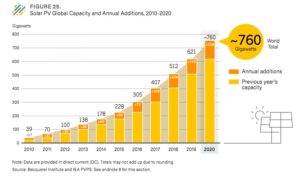The world added a record 256 gigawatts of renewables capacity in 2020, but that has made no real dent on the total proportion of energy derived from fossil fuels, which is the same today as it was 10 years ago.
REN21’s Renewable 2021 Global Status Report, released on Tuesday, found that in 2020 renewables made up a record 29 per cent of the global electricity mix. The 256 GW figure is the highest amount of renewable capacity ever added in a year, beating the previous record by almost 30 per cent.
Solar and wind drove the growth. The report estimated 139 GW of solar PV capacity came online in 2020, and 93 GW of wind. That brought the total global capacity to 760 GW of solar PV and 743 GW of wind.
But the report found little comfort in this fact, saying fossil fuels remained the dominant source of energy, making up 80.2 per cent of the world’s total energy supply, which includes transport. That’s almost exactly the same proportion as 10 years ago.
It found sectors outside electricity lagged, particularly transport and heating, thanks to a lack of aggressive policy. It criticised countries for failing to adopt clear, whole-of-economy renewable targets, saying 15 of the world’s 20 biggest economies had no such target.
The report said G20 countries had “barely met or even missed” their “unambitious” renewables targets, leaving the world “nowhere near the necessary paradigm shift towards a clean, healthier and more equitable energy future”.
“We are waking up to the bitter reality that the climate policy promises over the past ten years have mostly been empty words. The share of fossil fuels in final energy consumption has not moved by an inch,” said Rana Adib, REN21’s Executive Director.
“Phasing them out and making renewables the new norm are the strongest actions we can take.”
As the chart below shows, only two G20 countries derived more than 20 per cent of their total energy consumption from renewables – Brazil and Canada.
Only five had whole-of-economy targets, including the European Union. All of the latter were either current or former EU members, and so have been subject to the bloc’s Renewable Energy Directive, which aims to derive 32 per cent of all energy from renewable sources by 2030.

Australia is one of the G20 country that has failed to adopt whole-of-economy renewable energy targets.
The Clean Energy Council said the lapsing of the Large Scale Renewable Energy Target in 2020 meant Australia had no formal renewable energy target at all, even for the electricity sector, putting it behind the 165 countries around the world that do have one.
CEC chief executive Kane Thornton said this was leaving the states to do the heavy lifting, and he urged the federal government to take a more proactive stand, saying an opportunity was being missed.
“Australia has an opportunity to use our considerable renewable energy advantages to export Australian-made clean energy around the world and demonstrate how a modern, clean industrial sector can contribute to the global effort to curb the impacts of climate change,” he said.
Solar
Solar PV had a “rollercoaster year”, with 139 GW of new capacity added both on and off grid, bring total global capacity to around 760 GW.
South Australia got a special mention thanks to its huge rooftop PV rollout, which made it the “first large-scale system in the world to approach the point at which rooftop solar PV effectively eliminates demand for electricity from the grid”.

As usual, China led the world, adding 48.2 GW of PV capacity, including 32.7 GW of utility scale and 15.5 GW distributed. It was followed by the US at 19.2GW, Japan at 8.2 GW, and Germany at 4.9 GW. Australia added 4.1 GW of PV capacity, making it seventh in the world and responsible for 3 per cent of global new PV capacity in 2020.

Wind
Of the 93 GW if wind capacity added in 2020, the vast majority – 86.9 GW – was onshore. Despite being dwarfed by onshore, the 6.1 GW of offshore was the highest to date. For the first time, more money went into offshore wind that offshore oil or gas.

China again led the way, adding 52 GW of wind capacity, bringing its total wind capacity to 288.3 GW. It was followed by the US, which added 16.9 GW.

Australia added 1.1 GW of wind capacity at 10 new wind farms, bringing total wind capacity to nearly 7.4 GW.










